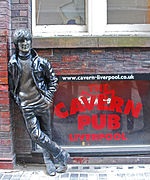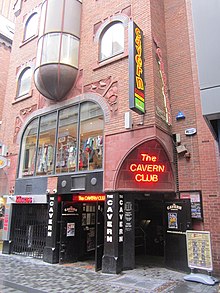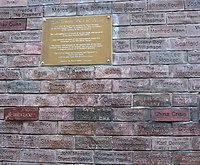Cavern Pub
The Cavern Club opened on 16 January 1957 as a jazz club, later becoming a centre of the rock and roll scene in Liverpool in the late 50s and early 1960s. The club became closely associated with Merseybeat and regularly played host to The Beatles in their early years.
The Cavern Club closed in 1973 and was filled in during construction work on the Merseyrail underground rail loop. It reopened in 1984. It was temporarily closed again from 1989 to 1991, and has been open ever since.
History of the Cavern Club
Early history
Alan Sytner, having been inspired by the jazz district in Paris where there were a number of clubs in cellars, returned to Liverpool and strove to open a club similar to the Le Caveau de la Huchette jazz club. He eventually found a fruit warehouse where people were leasing the cellar, which had been used as an air raid shelter in World War II. Tropical fruit used to be stored there and during warm months the scent from the ripening fruit was absorbed into the sandstone brickwork. When the club was packed with dancing and smoking teenagers, the heat produced resulted in the bricks sweating and the sweet fruit odour was absorbed into their clothing. After leaving, fans at bus stops could be identified as having visited the club by the pleasant 'Cavern Perfume' on their clothes.
The club opened on 16 January 1957 and the first act to perform there was the Merseysippi Jazz Band. Local commercial artist Tony Booth created the poster artwork for the opening night. He later became the original poster artist for the Beatles.
What started as a jazz club eventually became a hangout for skiffle groups. Whilst playing golf with Sytner's father, Dr. Joseph Sytner, Nigel Walley – who had left school at 15 to become an apprentice golf professional at the Lee Park Golf Club – asked Dr. Sytner if his son could book The Quarrymen at The Cavern, which was one of three jazz clubs he managed. Dr. Sytner suggested that the band should play at the golf club first, so as to assess their talent. Sytner phoned Walley a week later and offered the band an interlude spot playing skiffle between the performances of two jazz bands on Wednesday, 7 August 1957.
Before the performance, the Quarrymen argued amongst themselves about the set list, as rock 'n roll songs were definitely not allowed at the club but skiffle was tolerated. After opening with a skiffle song, John Lennon called for the others to start playing an Elvis Presley song, "Don't Be Cruel". Rod Davis warned Lennon that the audience would "eat you alive", but Lennon ignored this and started playing the song himself, forcing the others to join in. Halfway through, Sytner pushed his way through the audience and handed Lennon a note which read, "Cut out the bloody rock 'n roll". Paul McCartney's first appearance at The Cavern was with The Quarrymen on 24 January 1958. George Harrison first played at The Cavern during a lunchtime session on 9 February 1961.
Sytner sold the Cavern Club to Ray McFall in 1959 and moved to London. Blues bands and beat groups began to appear at the club on a regular basis in the early 1960s. The first Beat Night was held on 25 May 1960 and featured a performance by Rory Storm and the Hurricanes (which included Ringo Starr as drummer). By early 1961, Bob Wooler had become the full-time compère and organiser of the lunchtime sessions.
The club hosted its first performance by the Beatles on Thursday, 9 February 1961. Brian Epstein, the Beatles manager who secured the group's first recording contract, first saw the group perform at the club on 9 November 1961. Inspired by the group, Epstein made moves to take over their management.
The Beatles and others

The Beatles made their first appearance at the club on 9 February 1961 after returning to Liverpool from Hamburg, Germany, where they had been playing at the Indra and the Kaiserkeller clubs. Their stage show had been through a lot of changes, with some in the audience thinking they were watching a German band, as they were billed from Hamburg. From 1961 to 1963 the Beatles made 292 appearances at the club, with their last occurring on 3 August 1963, a month after the band recorded "She Loves You" and just six months before the Beatles' first trip to the U.S. By this time "Beatlemania" was sprouting across England, and with girls demanding to see the Beatles and screaming just to get a glimpse of them, the group had to hide or sneak into concerts, and the small club could no longer satisfy audience demand. After the Beatles' farewell gig on 3 August 1963, Bob Wooler gave their future dates to The Mastersounds, a local R&B band, led by Mal Jefferson. The Beatles had graduated from the club and had been signed to EMI's Parlophone label by producer George Martin. The amount of musical activity in Liverpool and Manchester caused record producers who had previously never ventured very far from London to start looking to the north.
In 1963, young local band The Hideaways were signed up to the newly founded Cavern Club agency and became the resident group, often stepping in for last minute artist cancellations; they also became the first pop group to appear on a nationwide television commercial for Timex Watch Company filmed by the Rank Organisation at the Cavern Club. The band also performed at the Cavern the night prior to the club's closure, making them the last group to perform on stage along with disc jockey Billy Butler and doorman Paddy Delaney, who—with fans—barricaded themselves into the club prior to the authorities' arrival the next morning to gain access. The Hideaways were also proactive along with local MP Bessie Braddock to reopen the Cavern; as a result they were the first group back on stage when the club re-opened on 23 July 1966 with local MP Bessie Braddock and then-Prime Minister Harold Wilson. The Hideaways also hold the official record of over 400 Cavern Club appearances at both old and new venues and are now recognised and named on the wall of fame.
South: The Cavern Walks Boutique Shopping Centre was built in 1984 and the current Cavern Club was opened in it.

